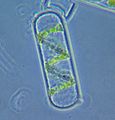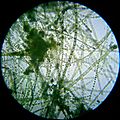Zygnematales facts for kids
Quick facts for kids Zygnematales |
|
|---|---|
| Scientific classification | |
| Kingdom: | |
| Division: | |
| Order: |
Zygnematales
|
| Families | |
|
|
The Zygnematales (say: ZIG-nuh-muh-TAY-leez), also called the Conjugales (say: KON-joo-GAY-leez), are a special group of green algae. There are thousands of different kinds of these algae. Some well-known examples are Zygnema and Spirogyra.
All members of this group grow into long, thin strands. These strands are not branched and are only one cell thick. They get longer as their cells divide. Most Zygnematales live in freshwater. They are a big part of the green, slimy layers of algae you might see on plants, rocks, or other things in the water.
Contents
What are Zygnematales?
Zygnematales are a type of algae, which are simple plant-like organisms. They are known for their unique way of reproducing. Unlike many plants, they don't have roots, stems, or leaves. Instead, they form long, thread-like chains of cells.
Their Structure
Each strand of Zygnematales is like a tiny green string. It is made up of many cells connected end-to-end. These strands are very thin, only one cell wide. They grow longer when each cell divides into two new cells. This process is called cell division.
Where Zygnematales Live
Most Zygnematales prefer to live in freshwater. You can find them in many different places, such as:
- Ponds
- Lakes
- Slow-moving rivers and streams
- Wet soil
- Even on damp rocks
They often form a green, slimy layer. This layer is sometimes called "algal scum." It can be seen floating on the water or attached to things underwater. Zygnematales are an important part of these watery homes. They help other living things by producing oxygen and being a food source.
How Zygnematales Reproduce
Zygnematales have a very interesting way of reproducing called conjugation. This is a type of sexual reproduction.
Conjugation Process
During conjugation, two different strands of Zygnematales come close together. They form a special tube between them. One cell from one strand then moves through this tube to join with a cell from the other strand. This joining creates a new cell called a zygospore. The zygospore is very tough and can survive harsh conditions. When conditions are right, the zygospore will grow into a new Zygnematales strand.
This process helps the algae to adapt and survive in different environments. It also helps to create new genetic combinations.
Examples of Zygnematales
Two of the most well-known types of Zygnematales are Spirogyra and Zygnema.
Spirogyra
Spirogyra is famous for its beautiful spiral-shaped chloroplasts. Chloroplasts are the parts of the cell that capture sunlight to make food. When you look at Spirogyra under a microscope, you can clearly see these green spirals inside each cell. It often forms large, slippery mats in ponds.
Zygnema
Zygnema is another common type of Zygnematales. Its chloroplasts are star-shaped. Like Spirogyra, Zygnema also forms long, unbranched filaments. It is often found in similar freshwater habitats.
Images for kids
-
Single Spirogyra cell
-
Spirogyra. Each numbered tick = 122 μM
-
Spirogyra. Each numbered tick = 20 μM
-
Microscopic view of Spirogyra conjugation
See also
 In Spanish: Zygnematales para niños
In Spanish: Zygnematales para niños






